SpaceX expanded its constellation of low Earth orbit satellites on Saturday with the launch of 53 Starlink satellites from Florida.
A Falcon 9 rocket lifted off from Cape Canaveral Space Force Station at 7.19 am local time, and deployed the satellites about 16 minutes after launch.
The rocket´s reusable first stage, which has been used for multiple launches, including the first crewed test flight of SpaceX's Crew Dragon spacecraft, successfully returned and landed on the 'Just Read the Instructions' droneship in the Atlantic Ocean.
Starlink is a satellite-based global internet system that SpaceX has been building for years to bring internet access to underserved areas of the world.
Earlier this week, SpaceX launched four astronauts to the International Space Station, including the 600th person to reach space in 60 years.

SpaceX expanded its constellation of low Earth orbit satellites with the launch of 53 Starlink satellites from Florida


The launch of 53 Starlinks is SpaceX's second rocket this week, and the 25th launch of the company this year. Starlink is a satellite-based global internet system that SpaceX has been building for years to bring internet access to underserved areas of the world
It took 21 hours for the flight from NASA´s Kennedy Space Center to reach the glittering outpost. SpaceX has now launched 1,844 Starlinks since the first two prototypes were sent up in 2018.
The launch of 53 Starlinks is SpaceX's second rocket this week, and the 25th launch of the company this year.
The astronauts got emotional when they first spotted the space station from 20 miles out, calling it 'a pretty glorious sight.'
Three astronauts welcomed the crew instead of the preferred seven. That´s because SpaceX brought four of them back on Monday after the launch of their replacements kept getting delayed.
The new crew will spend the next six months at the space station and, during that time, host two groups of visiting tourists.
Russia will launch the first group in December and SpaceX the second in February.
London-based rival OneWeb has launched 358 out of 648 planned internet satellites, Other companies, such as Amazon, are making plans for more.
Some, however, have opposed the launchings to low Earth orbit, citing that it might make space a more congested and dangerous place.
NASA has argued in the past that these probes need to be de-orbited reliably.

London-based rival OneWeb has launched 358 out of 648 planned internet satellites, Other companies, such as Amazon, are making plans for more

It took 21 hours for the flight from NASA´s Kennedy Space Center to reach the glittering outpost. SpaceX has now launched 1,844 Starlinks since the first two prototypes were sent up in 2018
Critics are concerned that possible collisions will become more frequent as the low Earth orbit becomes more crowded, a hypothetical scenario known as Kessler syndrome.
Users on Twitter voiced their worries on the subject. 'More junk orbiting earth, is it really necessary for all the satellites? All because someone wants a good signal for the internet when that can already be achieved,'
User @Boyanbc questioned the regulations to launch satellites and tweeted: 'Look, I'm not perse against it, but I just find it weird that I need permission from the authorities to change something in my backyard, but you can just dump thousands (in total 42k) satellites as you please. Just a tiny bit weird. Don't you think?'
But @localzuk contended that regulations already in place have been efficient.
'They have to go through a huge amount of regulatory red tape to get these things up there. Every last part of it goes through some approval or other. So, in essence, they need permission to do everything they've done as well,' they wrote.
In 2009, a derelict Russian satellite crashed into a US communications probe, causing massive orbital debris.
However, collisions have been rare ever since and the broadband services provided by the satellites could positively impact commerce and education.



Post a Comment